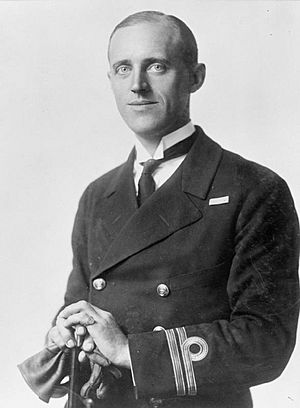Norman Douglas Holbrook facts for kids
Quick facts for kids
Norman Douglas Holbrook
|
|
|---|---|
 |
|
| Born | 9 July 1888 Southsea, Hampshire, England |
| Died | 3 July 1976 (aged 87) Midhurst, Sussex, England |
| Buried |
St James Old Churchyard, Stedham, West Sussex
|
| Allegiance | |
| Service/ |
|
| Rank | Commander |
| Commands held | HMS B11 |
| Battles/wars | World War I World War II |
| Awards | Victoria Cross Légion d'honneur (France) |
Commander Norman Douglas Holbrook (9 July 1888 – 3 July 1976) was a very brave British naval officer. He received the Victoria Cross (VC), which is the highest award for bravery in the British military. Holbrook was the first person serving in a submarine to ever receive the VC. It was also the first naval VC given out during World War I.
Contents
Norman Holbrook was born on 9 July 1888 in Southsea, Hampshire, England. He was the fourth son of Sir Arthur Holbrook. His father was a newspaper owner and later a Member of Parliament.
Norman went to Portsmouth Grammar School. In 1903, he joined the Britannia Royal Naval College. This college trains officers for the navy. He became a midshipman on 9 January 1905.
Joining the Submarine Service
Holbrook joined the submarine service in 1911. He served on several submarines. These included HMS F3, HMS V4, and HMS E41. On 30 December 1913, he took command of HMS B11.
Heroic Act in World War I
During World War I, Norman Holbrook was a lieutenant in the Royal Navy. He was 26 years old. On 13 December 1914, he performed a very brave act. This happened near the Dardanelles in Turkey.
Daring Submarine Mission
Holbrook was in command of HMS B11. This submarine was quite old, built in 1905. The Dardanelles Strait was very dangerous. It had strong currents and many enemy mines. Despite these dangers, Holbrook decided to go on a risky mission.
He dived his submarine under five rows of mines. This was incredibly dangerous. He then found and torpedoed the Ottoman ironclad Mesûdiye. This large enemy ship was guarding the minefield. The Mesûdiye sank after the attack.
Escape and Return
After sinking the ship, Holbrook and the B11 faced more danger. They were attacked by gunfire and torpedo boats. But Holbrook managed to bring the B11 safely back to the Mediterranean Sea.
The submarine had been underwater for nine hours. This was a very long time for a submarine of that era. For his incredible bravery, Holbrook was awarded the Victoria Cross. He later became a Commander in the Royal Navy.
Family Life
Norman Holbrook married Viva Dixon in 1919. They had a son together. Sadly, their son was killed while serving in World War II. Viva passed away in 1952. The next year, Holbrook married Gundula Bleichart.
Legacy and Recognition
Norman Holbrook passed away on 3 July 1976 in Midhurst, Sussex. He was buried in St James Old Churchyard in Stedham.
Town Named in His Honor
A town in New South Wales, Australia, was named after him. In 1915, during World War I, the town of Germanton changed its name to Holbrook. This was to honor his bravery. Norman Holbrook visited the town three times.
Medals and Memorials
Holbrook's Victoria Cross medal was given to the Council of the Shire of Holbrook in 1982. It is now displayed at the Australian War Memorial. A replica of his medal can be seen at the Submarine Museum in Holbrook, Australia.
A bronze statue of Norman Holbrook stands in Germanton Park in Holbrook, Australia. In Portsmouth, England, Holbrook Road is named after him. A plaque honoring him was placed on the Portsmouth Grammar School Junior School in 2014.
Images for kids

